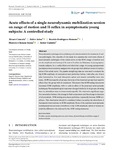Mostrar o rexistro simple do ítem
Acute effects of a single neurodynamic mobilization session on range of motion and H-reflex in asymptomatic young subjects: a controlled study
| dc.contributor.author | Cancela, Álvaro | |
| dc.contributor.author | Arias, Pablo | |
| dc.contributor.author | Rodríguez-Romero, Beatriz | |
| dc.contributor.author | Chouza-Insua, Marcelo | |
| dc.contributor.author | Cudeiro, Javier | |
| dc.date.accessioned | 2023-07-10T07:21:38Z | |
| dc.date.available | 2023-07-10T07:21:38Z | |
| dc.date.issued | 2023-06-18 | |
| dc.identifier.citation | Cancela Á, Arias P, Rodríguez-Romero B, Chouza-Insua M, Cudeiro J. Acute effects of a single neurodynamic mobilization session on range of motion and H-reflex in asymptomatic young subjects: a controlled study. Physiol Rep. 2023 Jun;11(12):e15748. | es_ES |
| dc.identifier.issn | 2051-817X | |
| dc.identifier.uri | http://hdl.handle.net/2183/33303 | |
| dc.description | Randomized controlled trial | es_ES |
| dc.description.abstract | [Abstract] Neurodynamic techniques have yielded good clinical results in the treatment of various pathologies. The objective of this study is to examine the short-term effects of neurodynamic techniques of the sciatic nerve on hip ROM (range of motion) and on the amplitude and latency of the soleus H-reflex and M-waves, in young asymptomatic subjects. In a double-blind controlled trial design, 60 young asymptomatic participants were randomly assigned into six groups with different levels of manipulation of the sciatic nerve. The passive straight leg raise test was used to evaluate the hip ROM amplitude. All evaluations were performed before, 1 min after, and 30 min after intervention. For each time-point, spinal and muscle excitability were also tested. ROM increased in all groups, but none of the treatment groups had superior effects than the group with no treatment. This means that ROM testing maneuvers increased ROM amplitude, with no add-on effect of the proposed neurodynamic techniques. Neurophysiological responses changed similarly in all groups, showing that the aftereffects were not intervention-specific. We observed a significant negative association between the change in limb temperature and the change in latencies of all potentials. ROM-testing procedures performed repeatedly increase ROM amplitude. This observation should be considered when evaluating the aftereffects of therapeutic interventions on ROM amplitude. None of the explored neurodynamic techniques produced acute aftereffects on hip ROM amplitude, spinal or muscle excitability different to the induced by the ROM testing maneuver. | es_ES |
| dc.language.iso | eng | es_ES |
| dc.publisher | Wiley | es_ES |
| dc.relation.uri | https://doi.org/10.14814/phy2.15748 | es_ES |
| dc.rights | Creative Commons Attribution 4.0 International Licence (CC-BY 4.0) | es_ES |
| dc.rights.uri | http://creativecommons.org/licenses/by/4.0/ | * |
| dc.subject | H-reflex | es_ES |
| dc.subject | Muscle stretching exercises | es_ES |
| dc.subject | Nerve tissue | es_ES |
| dc.subject | Physical therapy modalities | es_ES |
| dc.subject | Range of motion articular | es_ES |
| dc.title | Acute effects of a single neurodynamic mobilization session on range of motion and H-reflex in asymptomatic young subjects: a controlled study | es_ES |
| dc.type | info:eu-repo/semantics/article | es_ES |
| dc.rights.access | info:eu-repo/semantics/openAccess | es_ES |
| UDC.journalTitle | Psychological reports | es_ES |
| UDC.volume | 11 | es_ES |
| UDC.issue | 2 | es_ES |
| UDC.startPage | e15748 | es_ES |
Ficheiros no ítem
Este ítem aparece na(s) seguinte(s) colección(s)
-
GI-NEURO - Artigos [165]






